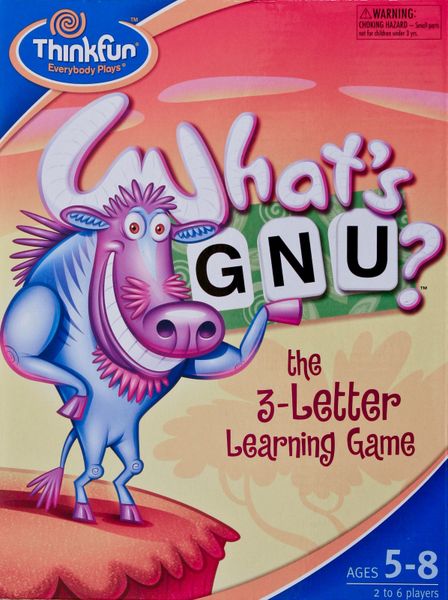What’s GNU? (2004) Board Game
What’s GNU? is a word game released in 2004 by ThinkFun. It is designed for children aged 5 and up, and is a fun and educational game that helps improve vocabulary and spelling skills. The game is based on the concept of homophones, which are words that sound the same but have different meanings.
Game Components of What’s GNU?
- Letter Tiles: The game includes 72 letter tiles that players use to form words.
- Word Cards: There are 36 word cards that serve as prompts or challenges for players.
- GNU Stand: A stand is included to hold the letter tiles, making it easier for players to manage their letters during gameplay.
How To Setup What’s GNU?
- Game Components: Ensure you have all necessary components:
- Prepare Word Starter Cards:
- Shuffle the Word Starter cards and place them face up in the center of the playing area. Each card features one letter and two blanks, prompting players to fill in the missing letters.
- Set Up the Letter Getter:
- Position the Letter Getter within reach of all players. This device will be used to reveal letter tiles during gameplay.
- Distribute Tiles:
- Place all letter tiles in a draw pile or container where players can draw from them easily.
- Determine the Starting Player:
- Decide who goes first, which can be done through any fair method (e.g., rolling a die).
- Gameplay Begins:
- On each turn, players will slide the Letter Getter to reveal two letter tiles and attempt to fill in the blanks on the Word Starter cards with valid three-letter words.
- End of Game:
Gameplay Mechanics and Game Objective
Turn Mechanics: On a player’s turn, they slide the Letter Getter to reveal two letter tiles.
Players must quickly use these tiles to fill in the blanks on the Word Starter cards, which each display one letter and two blanks (e.g., _ _ _).
Word Formation: Players create valid three-letter words by combining the revealed letters with the letters shown on the Word Starter cards.
The game encourages players to think creatively, allowing them to rearrange letters or change consonants and vowels to form new words.
Scoring: After all letter tiles have been used, players count the valid three-letter words they created.
The player with the most words at the end of the game is declared the winner.
Player Experience
Pros:
- Educational and fun way to improve vocabulary and spelling skills
- Great for children and families to play together
- Easy to learn and quick gameplay
Cons:
- Limited replay value once all word pairs have been used
- Some players may find the game too easy or too challenging depending on their vocabulary skills
Personal Thoughts on What’s GNU?
What’s GNU? is a great game for children to learn and have fun at the same time. The game is well-designed and provides a good challenge for players of all ages. However, the limited replay value may be a downside for some players. Overall, I would recommend this game for families looking for an educational and entertaining word game to play together. It is worth your time, especially if you have children who are learning vocabulary and spelling. However, for those looking for more complex and strategic games, What’s GNU? may not be the best choice.
Game Components of What’s GNU?
How To Setup What’s GNU?
To set up the game, players spread out the Word-Starter cards, which have one letter and two blanks. The Letter Getter is placed within reach of all players. This setup ensures that all players can see the Word-Starter cards and access the Letter Getter to reveal letter tiles.Gameplay Mechanics and Game Objective
Player Experience
**What’s GNU?** is designed for 2-6 players aged 5-8, making it an excellent tool for early and more advanced readers. The game is divided into two levels of play, ensuring it is engaging and challenging for a wide range of reading abilities. Players must think quickly to form words as the letter tiles are revealed, promoting real-time word recognition and formation skills.Pros
Cons
Personal Thoughts on What’s GNU?
**What’s GNU?** is an ideal game for parents, educators, or anyone looking to help children develop their reading and word formation skills in a fun and interactive way. The game’s ability to cater to both early and more advanced readers makes it a versatile addition to any educational or family game collection. However, its focus on three-letter words and its age targeting might make it less appealing for older children or adults looking for more complex word games.We are supported by our audience. When you purchase through links on our site, we may earn an affiliate commission, at no extra cost for you. Learn more.

